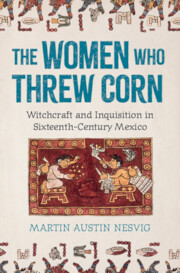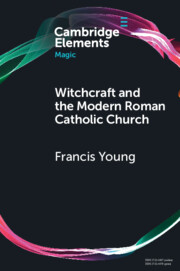Refine search
Actions for selected content:
15 results
Introduction
-
- Book:
- The Women Who Threw Corn
- Published online:
- 28 May 2025
- Print publication:
- 26 June 2025, pp 1-28
-
- Chapter
- Export citation
7 - Bad Girls Club
- from Part II - Magic in the 1520s and 1530s
-
- Book:
- The Women Who Threw Corn
- Published online:
- 28 May 2025
- Print publication:
- 26 June 2025, pp 160-186
-
- Chapter
- Export citation
2 - Mesoamerican Magic-Medicine
- from Part I - Witches and Their Enemies in the Early Modern World
-
- Book:
- The Women Who Threw Corn
- Published online:
- 28 May 2025
- Print publication:
- 26 June 2025, pp 55-74
-
- Chapter
- Export citation

The Women Who Threw Corn
- Witchcraft and Inquisition in Sixteenth-Century Mexico
-
- Published online:
- 28 May 2025
- Print publication:
- 26 June 2025
4 - Transformation and Otherness
-
- Book:
- The Shamanism of Eco-Tourism
- Published online:
- 30 January 2025
- Print publication:
- 06 February 2025, pp 82-103
-
- Chapter
- Export citation
Provocation by Witchcraft: Exploring the Evolution of the Kenyan Courts’ Interpretation of the Doctrine of Provocation in Relation to Witchcraft Beliefs
-
- Journal:
- Journal of Law and Religion / Volume 38 / Issue 2 / May 2023
- Published online by Cambridge University Press:
- 05 June 2023, pp. 265-289
-
- Article
-
- You have access
- Open access
- HTML
- Export citation
6 - Practice and Community in a Spiritual Borderland
- from Part II - The Caribbean in Veracruz
-
- Book:
- Veracruz and the Caribbean in the Seventeenth Century
- Published online:
- 19 January 2023
- Print publication:
- 19 January 2023, pp 192-225
-
- Chapter
- Export citation
Chapter 5 - Magic and the Elite
- from Part II - Service Magic among the Social Elite
-
- Book:
- Love Spells and Lost Treasure
- Published online:
- 06 January 2023
- Print publication:
- 22 December 2022, pp 177-223
-
- Chapter
- Export citation
Chapter 6 - Magic on Retainer
- from Part II - Service Magic among the Social Elite
-
- Book:
- Love Spells and Lost Treasure
- Published online:
- 06 January 2023
- Print publication:
- 22 December 2022, pp 224-245
-
- Chapter
- Export citation

Witchcraft and the Modern Roman Catholic Church
-
- Published online:
- 04 January 2022
- Print publication:
- 27 January 2022
-
- Element
- Export citation
2 - Heresy and Banditry: Religious Violence in China since 1850
- from Part I - Race, Religion and Nationalism
-
-
- Book:
- The Cambridge World History of Violence
- Published online:
- 13 March 2020
- Print publication:
- 26 March 2020, pp 41-67
-
- Chapter
- Export citation
31 - Spectacles of Violence in China
- from Part VII - Representations and Constructions of Violence
-
-
- Book:
- The Cambridge World History of Violence
- Published online:
- 13 March 2020
- Print publication:
- 26 March 2020, pp 612-633
-
- Chapter
- Export citation
Empedocles the Sorcerer and his Hexametrical Pharmaka
-
- Journal:
- Antichthon / Volume 53 / 2019
- Published online by Cambridge University Press:
- 12 December 2019, pp. 14-32
- Print publication:
- 2019
-
- Article
- Export citation
Understanding Social Resistance to the Ebola Response in the Forest Region of the Republic of Guinea: An Anthropological Perspective
-
- Journal:
- African Studies Review / Volume 59 / Issue 3 / December 2016
- Published online by Cambridge University Press:
- 19 December 2016, pp. 7-31
-
- Article
-
- You have access
- HTML
- Export citation
6 - Christianity and paganism, I: Egypt
- from Part II - Christianity Contested
-
-
- Book:
- The Cambridge History of Christianity
- Published online:
- 28 March 2008
- Print publication:
- 30 August 2007, pp 173-188
-
- Chapter
- Export citation
